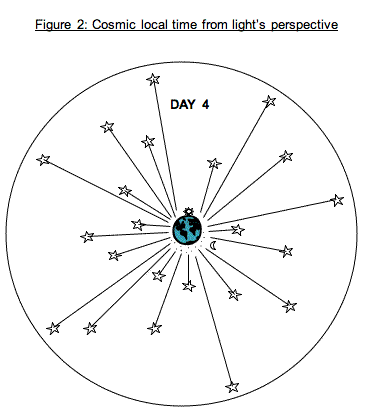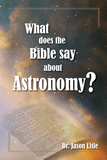
Does Answers in Genesis Accept “Billions of Years”?
With a better understanding of the concept of time, we will see that the article in question was in no way saying or implying the possibility of billions of years.
Dear Sirs:
I was shocked this morning when I logged on to your website and found the article “Distant Starlight and Genesis: Conventions of Time Measurement”. If, as that article claims, time is relative and the distant parts of the universe were actually created “billions of years before the beginning” according to one convention of measuring time, then it is pointless for you to insist that the universe was created in six literal days. If you believe the arguments in that article, which you yourselves posted on your own website, then henceforth you should just confine your ministry to the argument that God created our solar system in 6 literal days, that He created every kind of plant and animal supernaturally, without any evolutionary process, and that there was no suffering and death before Adam and Eve sinned a few thousand years ago. For years I have taught my children that God created the whole universe literally within 6 days, but your own article is saying time is relativistic and that the distant parts of the universe were created billions of years “before the beginning”, whatever you mean by that nonsensical phrase, and that the light from distant stars just arrived on earth on Day 4 of Creation week. How utterly confusing! Several years ago, my husband and I made what was, for us, a large donation to your Creation Museum, but now I am wondering if it was worth it. In your planetarium, are you going to be telling people that maybe the distant stars were created billions of years “before the beginning” and that their light reached earth on Day 4?
Thank you for contacting Answers in Genesis. I am writing to you on behalf of “Robert Newton” (the pen name used by Dr. Jason Lisle while he was working on his Ph.D.) to clarify more on his article.
This article was originally published in the peer-review process where new ideas are introduced and debated, e.g., creationist cosmologies such as this one. We encourage people to submit their papers through the peer-review process to ensure that their ideas are sound and consistent scientifically, logically and, most importantly, biblically. The theory presented is one of several models put forth to help explain the supposed “distant starlight” problem. At present, AiG does not have an official stance on which of these scientific models is best; we encourage readers to consider the strengths and weaknesses of each, and to remember that the ultimate authority is the Word of God. To hear more on this theory and other distant starlight theories, I recommend Dr. Lisle’s DVD Distant Starlight, which discusses several proposed cosmological models that are compatible with the Bible.
Dear friends at AiG,
I want to thank you for the wonderful work you do, including this website. I have often enjoyed your magazine, and some books, and now I have found JUST what I needed on your website. I am going to teach Sunday School for the first time and we’re starting with Creation. I needed help figuring out how to illustrate the first two days, especially. You have exactly the thing I needed to see! Thank you so very much for your very helpful website and for your ministry-‘upholding God's Word from the very first verse.’ Someone over here appreciates it!
God bless,
H.K., Los Palacios, Spain
With a better understanding of the concept of time, we will see that the article was in no way saying or implying the possibility of billions of years.
The issue of “time”
As was pointed out in the article, there are two methods (conventions) for measuring time: observed and calculated. First, here are the definitions from the article:
We shall call the the first ‘observed time’, in which the time of an event is described as when we see the event occur. The second definition we call ‘calculated time’, in which the time of an event is calculated by subtracting the light travel-time (distance to the event divided by the speed of light) from the observed time.
Today many people assume that “calculated time” is true time. However, time is not the rigid thing that most people think it is (as we will see). This doesn’t mean that time is arbitrary either (i.e., an ordinary day cannot be interpreted to mean “millions of years.”) But many people think that time is invariant—that it is measured the same by everyone regardless of velocity (as one example). But this is not so. For a given frame of reference (e.g., the earth) time is well-defined (a day is a day), so the variant nature of time cannot be used to justify progressive creation / the big bang, or other compromised views.
Furthermore, calculated time is a method of time measurement that seems to have come about rather recently. Conventions are by definition conventional; they are systems usually developed by man to measure things created by God or man. So, no convention of time measurement can be more “correct” than another. This would be like saying that the “correct” convention for measuring distance is the Imperial system (inches, feet, etc.). In the same way that the Fahrenheit and Celsius temperature scales have a different “zero” because they are different conventions, we will see that clocks can have a different “noon” depending on which convention we use. One method cannot be said to be “correct” over another. Each method is logical and consistent.
To more easily understand “observed time” vs. “calculated time,” let’s look at an example here on Earth. Time zones are an excellent analogy for understanding conventions of time measurement.
We start in New York City at 1:00 pm Eastern Time and start flying west towards Los Angeles (1:00 pm is the local time and is analogous to “observed time”). If we fly west quickly enough, we can reach Los Angeles at 1:00 pm Pacific Time. The local time is still 1:00 pm. As far as a passenger on the plane is concerned, she arrived at the same time as she left. By using local time the trip effectively took 0 minutes; it is as if it were instantaneous as measured by the time of the passenger. However, if the passenger used the time in New York (ET) as her reference (for both arrival and departure), then the arrival time was three hours after the departure time. As measured in universal time, the trip took three hours.
Now that we’re in Los Angeles, which is the “correct” time? 1:00 pm (local time) or 4:00 pm (Eastern Time)? Either convention of time measurement would be correct; however, which one would make more sense to use? Obviously, for some things it is more practical to use local time, but for other things it is more practical to use universal time. Also, notice that it is always possible to convert from local time to universal or vice versa if you know what time zone you are in.
“Observed time” is much like “local time”—except it is applied to space rather than earth. So let’s call it “cosmic local time.” “Calculated time” is much like universal time—but again, applied to outer space. So let’s call it “cosmic universal time.”
A brief history of cosmic universal time
The sun, moon and stars were used for most of history to tell time. Sundials and obelisks used the cosmic local time convention, since they are dependent on when the light reaches Earth (not on the light that just left the star).
The sun, moon and stars were used for most of history to tell time.
The water clock was one of the earliest methods of measuring time that does not rely on the sun, moon or stars. This was possibly invented by the Greeks, some believe, around 325 BC. Galileo is given credit by many for inventing the pendulum as early as 1582, and then in 1656 Christian Huygens made the first pendulum clock. Quartz clocks weren’t invented until the twentieth century.
Today we have atomic clocks that are accurate to within one-millionth of a second per year. Since the realization of cosmic universal time, the second had not been formally defined—until 1967, when it was defined as 9,192,631,770 vibrations of the cesium atom. This has become the standard for cosmic universal time. This was the first instance that time was not defined by the movement of astronomical bodies (cosmic local time).
As we can see from history, it would appear that this concept of cosmic universal time is an invention of man and is much more recent than cosmic local time, which has been in use since the beginning and is still used today.
A brief history of cosmic local time
The sun, moon and stars, throughout history, have been used to tell time. And this was one of their purposes and why they were created, according to the Bible (Genesis 1:14–18). Cosmic local time, it appears, was what was used in the beginning by God as a convention for time measurement for the Earth and its people to use. This doesn’t mean that it is wrong to use other conventions. For example, the Bible uses cubits to measure lengths, but we usually use “feet” or “meters” today. So, we must remember that modern conventions may not have been what the Scriptures used (much like the use of the word “dinosaur” as we’ve discussed elsewhere). So we must be careful that we are not “reading into the text” based on modern notions. We don’t want to read into the Bible that stars are made on day 4 cosmic universal time, if in fact the context indicates it is day 4 cosmic local time.
Throughout history, civilizations have used cosmic local time with the help of sundials, obelisks and even possibly merkhets. The sun, moon and stars were used to tell the time of day, evening, seasons, days and years (Genesis 1:14–19).
It would seem that throughout most of history cosmic local time was used, since that was the convention of time measurement that God created.
Then God said, “Let there be lights in the expanse of the heavens to separate the day from the night, and let them be for signs and for seasons and for days and years; and let them be for lights in the expanse of the heavens to give light on the earth” and it was so. God made the two great lights, the greater light to govern the day, and the lesser light to govern the night; He made the stars also. God placed them in the expanse of the heavens to give light on the earth, and to govern the day and the night, and to separate the light from the darkness; and God saw that it was good. There was evening and there was morning, a fourth day. (Genesis 1:14–19)
He made the moon for the seasons; The sun knows the place of its setting. (Psalm 104:19)
Light and General Relativity

Many people make the assumption, probably unknowingly, that the rate of time is static, that it does not change. However, as Einstein discovered, the rate of time is relative and not absolute. It is actually a physical process that God created (Genesis 1:1). As has been measured, the rate of time is affected by two measurable phenomena: gravity and velocity. The greater the gravity, the slower time will pass.
A clock at sea level has been shown to run more slowly than one on top of a mountain, because the one at sea level is affected by more gravity. This is an effect known as time dilation, and has been experimentally demonstrated (see Do Creationists Believe in “Weird” Physics like Relativity, Quantum Mechanics, and String Theory?).
Velocity affects time in a rather unexpected way: the faster the velocity, the more time slows. Theoretically, by moving at the speed of light, time actually stops. For example, we normally think of light taking eight minutes to get from the sun to the earth, but from the light’s perspective, the trip is instantaneous. This would also apply to stars billions of light years away. Using cosmic universal time (a convention of measurement invented by man from our perspective here on Earth) the light would take billions of years to get here; however, that is using our (Earth’s) clocks and our modern convention of time measurement (cosmic universal time). If we use cosmic local time, the trip is effectively instantaneous. From the light’s “point of view,” the trip is instantaneous in either convention (since light does not experience time).
Cosmic local time and creation
Let’s apply the time zone example discussed earlier to starlight. In the illustrations below, each circle represents a “cosmic time zone” (Figures 1a–f). We start out at the farthest stars being created on day 4 (just like leaving New York City at 1:00 pm). As we move to the next “cosmic time zone,” heading toward the earth, it is still day 4. (Each line represents a star’s light.) Finally the starlight reaches the earth, still on day 4 of the last “cosmic time zone” (just like reaching Los Angeles at 1:00 pm from New York City).

These “time zones” help illustrate the difference between cosmic local time and cosmic universal time. Just as it took us three hours to fly from New York City to Los Angeles, so it would seem it took five days for the starlight from the outermost circle to reach the earth (in the illustration). Likewise, you might think that light from a star that is billions of light-years away would experience billions of years to get here. But this is where the analogy breaks down. Whereas a passenger on the plane really would experience three hours of flying time, light does not. From the light’s point of view the trip is instantaneous. So, the idea that cosmic local time somehow allows billions of years is not correct. No one on Earth or even the light itself would experience billions of years. So, Dr. Lisle’s suggestion that the Bible is using cosmic local time (rather than cosmic universal time) does not allow for anyone (or anything) to experience billions of years of history. If the model is true, then virtually everything we see in the universe today is only a few thousand years old.1
Perhaps some people are bothered that converting from cosmic local time to cosmic universal time implies that the stars were created before Day 4, even billions of years before. But since cosmic universal time appears to be a modern invention, any extra time that is added in is “artificial” at best and would not be experienced or measured by anyone or anything. We could write down several extra zeros to our bank balance statement and pretend to be a billionaire, but would we really be one? If we tried to spend that money, we’d be in real trouble. Converting from cosmic local time to cosmic universal time does not actually create billions of years of history any more than writing extra zeros to our bank statement would make us a real billionaire.
Conclusion
At this point, you might be tempted to think “So which is the correct convention? Is it cosmic universal time, or cosmic local time?” But of course, conventions can’t be “correct” in that sense. It’s a bit like asking whether “inches” or “centimeters” is the “correct” convention. Each is useful. The real question should be “Which convention does the Bible use?” We see in Scripture much support for God’s invention and use of cosmic local time. Those in the Bible relied on when light reached them, not from when it left its source—which would be a different time if measured in cosmic universal time; in fact, this is primarily what we do today as well (e.g., when we see a star explode we name the event based on when the light arrives.). By using the clock from the perspective of the starlight (cosmic local time), we see that stars were created on day 4 and that the light arrived on day 4 even though thousands of years later we could “calculate” (using man’s invented time convention: cosmic universal time) a different travel time for the light and a different associated “date” of light emission. Although cosmic universal time is useful in many instances, Dr. Lisle has suggested that it is a recent invention and is not the convention used to mark time in the Scriptures.
These are difficult concepts; the nature of spacetime is not intuitive. So, we wouldn’t expect readers who are not trained in physics to understand every nuance of this model. The points we’d want people to “take home” are these: (1) The stars really were created on day 4 (they didn’t just “appear” on that day—they were created on that day). (2) There are perfectly legitimate ways of marking time in which light would have also reached earth on day 4, and so distant starlight does not prove there were ever “billions or years.” (3) Most importantly, the Bible is absolutely correct about the age of the universe (as it is in all matters). So, regardless of whether or not the above model is they way God chose to get the light here, we can trust that the Lord really did make the stars on Day 4 just as He says in His Word.
David Wright, AiG–USA
Footnotes
- This is only another model to help explain distant starlight. It is not intended to be the “one and only solution.” There are other great models still out there such as ones by Dr. Russell Humphrey’s (Starlight and Time) and Dr. John Hartnett (“A new cosmology: solution to the starlight travel time problem”).
Recommended Resources

Answers in Genesis is an apologetics ministry, dedicated to helping Christians defend their faith and proclaim the good news of Jesus Christ.
- Customer Service 800.778.3390
- Available Monday–Friday | 9 AM–5 PM ET
- © 2025 Answers in Genesis




